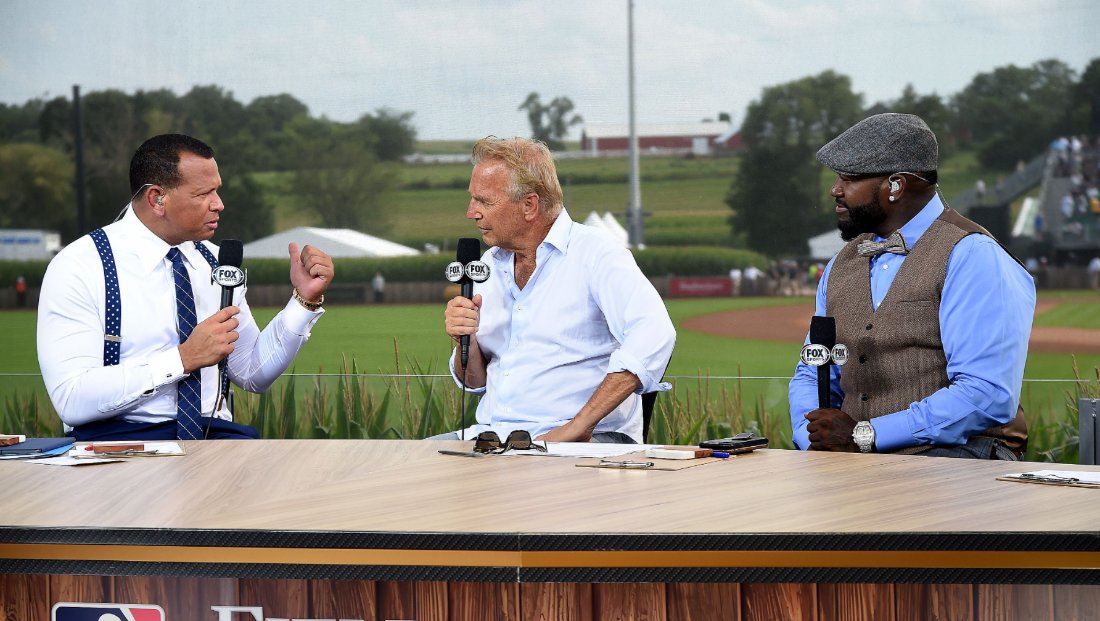AJA FS-HDR used in Fox’s ‘Field of Dreams’ MLB broadcast

Achieving a post-produced look in live television is the ultimate goal, but demands the right combination of technology and engineering expertise, and a lot of experimentation as Fox uncovered during its “Field of Dreams” inspired MLB broadcast last summer.
Brad Cheney, VP of Field Operations and Engineering at Fox Sports, helped spearhead the production, which fused live coverage of an MLB game between the Yankees and the White Sox, with pre-produced and live elements inspired by the film.
The game was held in a custom-built stadium near the original “Field of Dreams” set in Dyersville, IA, and shot using a unique combination of cameras, with footage prepared in a range of delivery formats for distribution needs. To deliver a cohesive look with a cinematic feel for the production, the team used 60 AJA FS-HDRs for signal conversion, frame synchronization, and color correction in the field.
“Creating shallow depth of field looks requires specialized equipment, like cinematic cameras with large sensors and prime lenses. To recreate the color, warmth, and feel of the movie “Field of Dreams,” we leaned on those camera setups and our AJA gear,” shared Cheney. “Using FS-HDR, we were able to create that curve which strikes the right balance between broadcast and cinematic, and an ability to move between them seamlessly. Having such a robust color correction toolset built into our converter was paramount, considering we used 1080p and 4K SDR camera sets.”
Preparations for the production began more than a year in advance, with the team using the MLB all-star game as a testbed. During this time, Fox’s postseason baseball group, video team, replay group, lead technical director, technology group, ENG crew, and drone professionals worked closely with equipment vendors to explore their options, ultimately landing on 1080p HDR, HLG wide color gamut BT.2020 as the single master production format. At the same time, they wanted to remain flexible for distribution partners requiring other delivery formats.
The team leveraged an amalgamation of cameras across the production comprising tried and true broadcast cameras as well as 12 cinema cameras. The lineup included a Sony Venice with PL mount lenses; Sony F55, 4300, 5500 and P50 cameras; and RED cameras, including the KOMODO, in addition to 1080p-capable POV cameras buried around the infield as well as drone cameras. However, incorporating different camera formats into one cohesive look required a myriad of conversion capabilities. Throughout the production the FS-HDR supported this need, with all of the cinema camera feeds run through them.
“Starting with the highest image quality possible will always result in the best final product, and even though much of the audience tuned into the feed in SDR, we wanted to do as much as we could in HDR to elevate the viewing experience. AJA FS-HDRs helped make that possible,” Cheney added. “They allowed us to create that cinematic look we were going for with full range color correction.”
Overall, the process required hours of R&D, with the team testing out different equipment settings and weighing its options. Regarding frame rate, in some situations 24p was a perfect fit, while it proved not right in others, in which case the team opted for 29.97p for many of our cameras. Then, Fox also had to account for other subtleties in the look based on the equipment.
“Ultimately, our approach ensured we had the right conversion and settings in all the right places and gave us an appreciation for recent technological evolutions. It’s amazing that you can have an RF transmitter that can do 24, 25, 29, 50, 60 and 59.94, and the same thing is to be said for conversion gear like the FS-HDR that can do so many things at once,” explained Cheney. “With the FS-HDR, we can better control what the picture will look like, because we can quickly move between looks, line them up, and A/B them to get a clear picture of what’s going on. In the end, this was key, because the timeline was tight, and we had a set amount of time to make choices in a live environment. We made a lot of choices based on research leading up to the production that got us to a concept of where we wanted to be, and once the real-world lighting conditions showed up, we knew what we needed to do to get there.”
The next test phase came once the team arrived in Iowa the week of the event. There, they determined the final approach to blend the look they’d established for the all-star game with that of the original set and film as well as real-time environmental conditions like natural lighting. They presented various options to production, and then made final equipment modifications and refined the workflow until they achieved their desired look. Cheney added, “Showing live action and replays with the same beautiful post-produced look that you’d expect from cinematic highlight shows in a live production setup was one of those beautiful television moments. It made the game feel bigger than life for all of us working on the project as well as the viewers.”
Having successfully executed the project to rave fan reviews, Cheney and team are confident they now have the proper roadmap in place to deliver similar quality broadcasts in the future.
He concluded, “We now know how to execute something like this quickly, so moving forward, we can easily provide this amazing depth of field and color to audiences in live broadcasts where it makes sense. From an industry standpoint, we’re on the cusp of being able to do all the things we want to in sports with high frame rate cameras and with a cinematic look, things that just weren’t achievable five or ten years ago. We’ve now reached a point where this technique can be applied to other productions on a full-time basis versus just as an added feature for select matches, and that will be a game-changer for the live production world moving forward.”
Subscribe to NCS for the latest news, project case studies and product announcements in broadcast technology, creative design and engineering delivered to your inbox.




Categories
4K, HDR and UHD Broadcasting, Broadcast Engineering, Broadcast Equipment, Industry Feed, Signal Processing
The content on this page is provided by the featured companies. NewscastStudio cannot guarantee the accuracy or veracity of any claims about products or services made in this content. The views expressed in this content do not necessarily reflect the views of NewscastStudio or its team. This content may contain trademarks owned by third parties, and those marks are the property of those companies.